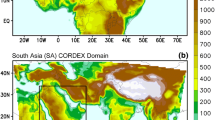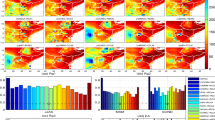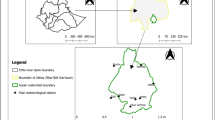Abstract
The present study evaluates the performance of Conformal-Cubic Atmospheric Model (CCAM) simulations downscaled from six global climate models (GCMs) (i.e., ACCESS1.0, CNRM-CM5, CCSM4, GFDL-CM3, MPI-ESM-LR, and NorESM-M) and Max Plank’s Regional Model (REMO2009(MPI)) obtained from the South-Asia Coordinated Regional Climate Downscaling Experiment (CORDEX) for analyzing the summer monsoon maximum temperature (Tmax) over the fifteen Agro-Climatic Zones (ACZs) in India. The model simulations are compared with the two sets of observed data obtained from the India Meteorology Department (IMD) and Climate Research Unit (CRU) for the period from 1981 to 2005. The results illustrate that the skill of CCAM regional climate models (RCMs) is higher than the REMO in simulating the Tmax over all the regions. The spatial patterns of Tmax in CCAM (CCSM) and CCAM (CNRM) are closer to IMD, while the Tmax distributions in CCAM (CNRM), CCAM (CCSM), and CCAM (BCCR) agree well with the CRU, and correlation coefficient (CC) is more than 0.6; however, large positive biases in all RCMs are depicted over the Himalayan regions. The inter-comparison among all the RCMs suggest that the CCAM (CNRM) and CCAM (CCSM) are rendering as the foremost models in simulating Tmax over different ACZs. Performances of these two models also infer the usefulness of the model products for impact studies over the individual ACZs. However, the existing systematic biases in the RCMs impeded the model performance and it is necessary to remove the model bias prior to some real-time application. In this study, two bias correction methods, i.e., linear scaling (LS) and distribution mapping (DM), have been used to correct RCM output bias. It is found that the model performance using DM correction is better than LS method. The performance validations are evaluated based on the probability density function (PDF), CC, and standard deviation (SD) with 95% confidence level. The model evaluation has also been justified using mean absolute error (MAE) index, Nash-Sutcliffe coefficient (NS) index, percent bias (Pbias), and the Willmott’s index of agreement (d) which confirm the research findings. The results are providing an effective guidance on the usefulness of bias corrected RCMs over a particular ACZs for impact assessment.








Similar content being viewed by others
References
Alagh YK, Kashyap SP, Murthy GVSN (1989) Agro- climatic regional planning: an overview. Planning Commission, New Delhi
Almazroui M (2012) Dynamical downscaling of rainfall and temperature over the Arabian peninsula using RegCM4. Clim Res 52:49–62. https://doi.org/10.3354/cr01073
Bal PK, Ramachandran A, Palanivelu K, Thirumurugan P, Geetha R, Bhaskaran B (2016) Climate change projections over India by a downscaling approach using PRECIS. Asia-Pac J Atmos Sci 52(4):353–369
Basha G, Kishore P, Ratnam MV, Jayaraman A, Kouchak AA, Ouarda TB, Velicogna I (2017) Historical and projected surface temperature over India during the 20th and 21st century. Sci Rep 7(1):2987
Bhatla R, Ghosh S, Mandal B, Mall RK, Sharma K (2016) Simulation of Indian summer monsoon onset with different parameterization convection schemes of RegCM-4.3. Atmos Res 176:10–18. https://doi.org/10.1016/j.atmosres.2016.02.010
Bhatla R, Ghosh S, Mall RK, Sinha P, Sarkar A (2018a) Regional climate model performance in simulating intra-seasonal and interannual variability of Indian summer monsoon. Pure Appl Geophys 175:3697–3371. https://doi.org/10.1007/s00024-018-1886-x
Bhatla R, Mandal B, Verma S, Ghosh S, Mall RK (2018b) Performance of regional climate model in simulating monsoon onset over Indian subcontinent. Pure Appl Geophys 176:409–420. https://doi.org/10.1007/s00024-018-1910-1
Bhatla R, Ghosh S, Verma S, Mall RK, Gharde GR (2019a) Variability of monsoon over homogeneous regions of India using regional climate model and impact on crop production. Agriculture Research 8(3):331–346
Bhatla R, Verma S, Ghosh S, Mall RK (2019b) Performance of regional climate model in simulating Indian summer monsoon over Indian homogeneous region. Theor Appl Climatol 139(3):1121–1135. https://doi.org/10.1007/s00704-019-03045-x
Bhatla R, Verma P, Verma S, Ghosh S (2020a) El Nino/La Nina impact on crop production over different agro-climatic zones of indo-Gangetic plain of India. Theor Appl Climatol. https://doi.org/10.1007/s00704-020-03284-3
Bhatla R, Verma S, Ghosh S, Gupta A (2020b) Abrupt changes mean temperature variations over India during 1901-2010. J. Earth Syst. Sci 129. https://doi.org/10.1007/s12040-020-01421-0
Bhatt D, Sonkar G, Mall RK (2019) Impact of climate variability on the rice yield in Uttar Pradesh: an agro-climatic zone based study. Environmental Processes 6(1):135–153. https://doi.org/10.1007/s40710-019-00360-3
Birthal PS, Negi DS, Kumar S, Aggarwal S, Suresh A, Khan M (2014) How sensitive is Indian agriculture to climate change? Indian Journal of Agricultural Economics 69(902-2016-68357):474-487
Dash SK, Mamgain A, Pattnayak KC, Giorgi F (2013) Spatial and temporal variations in Indian summer monsoon rainfall and temperature: an analysis based on RegCM3 simulations. Pure Appl Geophys 170(4):655–674
Déqué M, Rowell DP, Luthi D, Giorgi F, Christensen JH, Rockel B, Jacob D, Kjellström E, Castro M, van den Hurk B (2007) An intercomparison of regional climate simulations for Europe: assessing uncertainties in model projections. Clim Chang 81:53–70
Fang G, Yang J, Chen YN, Zammit C (2015) Comparing bias correction methods in downscaling meteorological variables for a hydrologic impact study in an arid area in China. Hydrol Earth Syst Sci 19(6):2547–2559
Field CB (2014) Climate change 2014–Impacts, adaptation and vulnerability: regional aspects. Cambridge University Press
Fowler HJ, Ekström M, Blenkinsop S, Smith AP (2007) Estimating change in extreme European precipitation using a multi-model ensemble. Journal of Geophysical Research: Atmospheres 112(D18)
Ghosh S, Bhatla R, Mall RK, Srivastava PK, Sahai AK (2019) Aspect of ECMWF downscaled regional climate modeling in simulating Indian summer monsoon rainfall and its dependencies on lateral boundary conditions. Theor Appl Climatol 135(3–4):1559–1581
Giorgi F, Francisco R (2000) Uncertainties in regional climate change prediction: a regional analysis of ensemble simulations with the HADCM2 coupled AOGCM. Clim Dyn 16(2–3):169–182
Giorgi F, Gutowski WJ (2016) Coordinated experiments for projections of regional climate change. Current Climate Change Reports 2(4):202–210
Giorgi F, Jones C, Asrar GR (2009) Addressing climate information needs at the regional level: the CORDEX framework. World meteorological organisation (WMO). Bulletin 58:175
Giorgi F, Coppola E, Solmon F, Mariotti L, Sylla MB, Bi X, Elguindi N, Diro GT, Nair V, Giuliani G, Turuncoglu UU (2012) RegCM4: model description and preliminary tests over multiple CORDEX domains. Clim Res 52:7–29
Gudmundsson L, Bremnes JB, Haugen JE, Engen-Skaugen T (2012) Downscaling RCM precipitation to the station scale using statistical transformations–a comparison of methods. Hydrol Earth Syst Sci 16(9):3383–3390
Hijioka Y, Lin E, Pereira JJ, Corlett RT, Cui X, Insarov GE, Lasco RD, Lindgren E, Surjan A (2014) Part B: regional aspects. Contribution of Working Group II to the Fifth Assessment Report of the Intergovernmental Panel on Climate Change
Huang DQ, Zhu J, Zhang YC, Huang AN (2013) Uncertainties on the simulated summer precipitation over eastern China from the CMIP5 models. Journal of Geophysical Research: Atmospheres 118(16):9035–9047
Iizumi T, Furuya J, Shen Z, Kim W, Okada M, Fujimori S, Hasegawa T, Nishimori M (2017) Responses of crop yield growth to global temperature and socioeconomic changes. Sci Rep 7(1):7800
Jakob Tß1M, Gobiet A, Leuprecht A (2011) Empirical-statistical downscaling and error correction of daily precipitation from regional climate models. Int J Climatol 10:1530–1544
Jayasankar CB, Surendran S, Rajendran K (2015) Robust signals of future projections of Indian summer monsoon rainfall by IPCC AR5 climate models: role of seasonal cycle and interannual variability. Geophys Res Lett 42:3513–3520
Kodra E, Ghosh S, Ganguly AR (2012) Evaluation of global climate models for Indian monsoon climatology. Environ Res Lett 7(1):014012
Kumar KR, Sahai AK, Kumar KK, Patwardhan SK, Mishra PK, Revadekar JV, Kamala K, Pant GB (2006) High-resolution climate change scenarios for India for the 21st century. Curr Sci 90(3):334–345
Leander R, Buishand TA, van den Hurk BJ, de Wit MJ (2008) Estimated changes in flood quantiles of the river Meuse from resampling of regional climate model output. J Hydrol 351(3–4):331–343
Li H, Sheffield J, Wood EF (2010) Bias correction of monthly precipitation and temperature fields from intergovernmental panel on climate change AR4 models using equidistant quantile matching. Journal of Geophysical Research: Atmospheres 115(D10)
Luo M, Liu T, Meng F, Duan Y, Frankl A, Bao A, De Maeyer P (2018) Comparing bias correction methods used in downscaling precipitation and temperature from regional climate models: a case study from the Kaidu River basin in Western China. Water 10(8):1046
Mall RK, Singh R, Gupta A, Srinivasan G, Rathore LS (2006) Impact of climate change on Indian agriculture: a review. Clim Chang 78(2–4):445–478
Mall RK, Sonkar G, Bhatt D, Sharma NK, Baxla AK, Singh KK (2016) Managing impact of extreme weather events in sugarcane in different agro-climatic zones of Uttar Pradesh. Mausam 67(1):233–250
Mall RK, A Gupta, Geetika S (2017) Effect of Climate change on crop production. In ‘Current Developments in Biotechnology and Bioengineering, 1st Edition: Crop Modification, Nutrition and Food Production’ (Eds. Dubey, Ashok Pandey & Sangwan) Elsevier publication (16 Sept. 2016) Print Book ISBN: 9780444636614, pp 23–46. https://doi.org/10.1016/C2014-0-04871-X
Mall RK, Singh N, Singh KK, Sonkar G, Gupta A (2018) Evaluating the performance of RegCM4. 0 climate model for climate change impact assessment on wheat and rice crop in diverse agro-climatic zones of Uttar Pradesh, India. Clim Chang 149(3–4):503–515
Mall RK, Srivastava RK, Banerjee T, Mishra OP, Bhatt D, Sonkar G (2019) Disaster risk reduction including climate change adaptation over South Asia: challenges and ways forward. International Journal of Disaster Risk Science 10(1):14–27. https://doi.org/10.1007/s13753-018-0210-9
Maraun D, Wetterhall F, Ireson AM, Chandler RE, Kendon EJ, Widmann M, Brienen S, Rust HW, Sauter T, Themeßl M, Venema VK (2010) Precipitation downscaling under climate change: recent developments to bridge the gap between dynamical models and the end user. Rev Geophys 48(3)
McGinnis S, Nychka D, Mearns LO (2015) A new distribution mapping technique for climate model bias correction. In Machine learning and data mining approaches to climate science (91–99).Springer, Cham
Mishra AK, Dwivedi S (2019) Assessment of convective parametrization schemes over the Indian subcontinent using a regional climate model. Theor Appl Climatol 137:1747–1764
Mishra V, Kumar D, Ganguly AR, Sanjay J, Mujumdar M, Krishnan R, Shah RD (2014) Reliability of regional and global climate models to simulate precipitation extremes over India. Journal of Geophysical Research: Atmospheres 119:9301–9323
Mishra SK, Sahany S, Salunke P (2018) CMIP5 vs. CORDEX over the Indian region: how much do we benefit from dynamical downscaling? Theor Appl Climatol 133(3–4):1133–1141
Mishra AK, Dwivedi S, Das S (2020) Role of Arabian Sea warming on the indian summer monsoon rainfall in a regional climate model. Int J Climatol 40(4):2226–2238
Murphy J (1999) An evaluation of statistical and dynamical techniques for downscaling local climate. J Clim 12(8):2256–2284
Nash JE, Sutcliffe JV (1970) River flow forecasting through conceptual models part I- a discussion of principles. J Hydrol 10(3):282–290
Piani C, Haerter JO, Coppola E (2010a) Statistical bias correction for daily precipitation in regional climate models over Europe. Theor Appl Climatol 99(1–2):187–192
Piani C, Weedon GP, Best M, Gomes SM, Viterbo P, Hagemann S, Haerter JO (2010b) Statistical bias correction of global simulated daily precipitation and temperature for the application of hydrological models. J Hydrol 395(3–4):199–215
Piao S, Ciais P, Huang Y, Shen Z, Peng S, Li J, Zhou L, Liu H, Ma Y, Ding Y, Friedlingstein P (2010) The impacts of climate change on water resources and agriculture in China. Nature 467(7311):43–51
Pradhan R, Goroshi SK, Singh RP (2014) Spatial and seasonal characterization of terrestrial biospheric carbon flux over India using GOSAT data. The International Archives of Photogrammetry, Remote Sensing and Spatial Information Sciences 40(8):617
Sabin TP, Krishnan R, Ghattas J, Denvil S, Dufresne JL, Hourdin F, Pascal T (2013) High resolution simulation of the south Asian monsoon using a variable resolution global climate model. Clim Dyn 41:173–194
Singh N, Mall RK, Sonkar G, Singh KK, Gupta A (2018) Evaluation of RegCM4 climate model for assessment of climate change impact on crop production. Mausam 551(1):631–655
Sinha P, Mohanty UC, Kar SC, Dash SK, Kumari S (2013) Sensitivity of the GCM driven summer monsoon simulations to cumulus parameterization schemes in nested RegCM3. Theor Appl Climatol 112(1–2):285–306
Sinha P, Mohanty UC, Kar SC, Kumari S (2014) Role of the Himalayan orography in simulation of the Indian summer monsoon using RegCM3. Pure Appl Geophys 171:1385–1407
Sonkar G, Mall RK, Banerjee T, Singh N, Kumar TL, Chand R (2019) Vulnerability of Indian wheat against rising temperature and aerosols. Environ Pollut 254:112946. https://doi.org/10.1016/j.envpol.2019.07.114
Sonkar G, Singh N, Mall RK, Singh KK, Gupta A (2020) Simulating the impacts of climate change on sugarcane in diverse agro-climatic zones of northern India using CANEGRO-sugarcane model. Sugar Tech 22:460–472. https://doi.org/10.1007/s12355-019-00787-w
Srivastava AK, Rajeevan M, Kshirsagar SR (2009) Development of a high resolution daily gridded temperature data set (1969–2005) for the Indian region. Atmos Sci Lett 10(4):249–254
Taylor KE (2001) Summarizing multiple aspects of model performance in a single diagram. Journal of Geophysical Research: Atmospheres 106(D7):7183–7192
Terink W, Hurkmans RT, Torfs PJ, Uijlenhoet R (2010) Evaluation of a bias correction method applied to downscaled precipitation and temperature reanalysis data for the Rhine basin. Hydrol Earth Syst Sci 14(4):687–703
Teutschbein C, Seibert J (2012) Bias correction of regional climate model simulations for hydrological climate-change impact studies: review and evaluation of different methods. J Hydrol 456:12–29
Themeßl MJ, Gobiet A, Heinrich G (2012) Empirical-statistical downscaling and error correction of regional climate models and its impact on the climate change signal. Clim Chang 112(2):449–468
Tiwari PR, Kar SC, Mohanty UC, Dey S, Kumari S, Sinha P (2016a) Seasonal prediction skill of winter temperature over North India. Theor Appl Climatol 124:15–29
Tiwari PR, Kar SC, Mohanty UC, Dey S, Sinha P, Raju PV, Shekhar MS (2016b) On the dynamical downscaling and bias correction of seasonal-scale winter precipitation predictions over North India. Q J R Meteorol Soc 142(699):2398–2410
Tyagi S, Singh N, Sonkar G, Mall RK (2019) Sensitivity of evapotranspiration to climate change using DSSAT model in sub humid climate region of eastern Uttar Pradesh. Modelling Earth Systems and Environment 5:1–11. https://doi.org/10.1007/s40808-018-0513-2
Willmott CJ, Wicks DE (1980) An empirical method for the spatial interpolation of monthly precipitation within California. Phys Geogr 1(1):59–73
Wood AW, Leung LR, Sridhar V, Lettenmaier DP (2004) Hydrologic implications of dynamical and statistical approaches to downscaling climate model outputs. Clim Chang 62(1–3):189–216
Yadav MK, Singh RS, Singh KK, Mall RK, Patel C, Yadav SK, Singh MK (2016) Assessment of climate change impact on pulse, oilseed and vegetable crops at Varanasi, India. Journal of Agrometeorology 18(1):13
Yang T, Hao X, Shao Q, Xu CY, Zhao C, Chen X, Wang W (2012) Multi-model ensemble projections in temperature and precipitation extremes of the Tibetan plateau in the 21st century. Glob Planet Chang 80:1–13
Zacharias M, Kumar SN, Singh SD, Rani DS, Aggarwal PK (2015) Evaluation of a regional climate model for impact assessment of climate change on crop productivity in the tropics. Curr Sci 108(6):1119–1126
Acknowledgments
Authors are gratefully acknowledging the World Climate Research Programme’s Working Groups, former coordinating body of CORDEX and CMIP5. The climate modeling groups (listed in Table 1) are sincerely thanked for producing and making available their model output. The authors thank the Earth System Grid Federation (ESGF) infrastructure and the Climate Data Portal hosted at the Centre for Climate Change Research (CCCR), Indian Institute of Tropical Meteorology (IITM), for providing CORDEX South Asia data. The authors wish to thank to the India Meteorology Department (IMD) and the Climatic Research Unit (CRU) of the University of East Anglia for making available the observation dataset. The authors sincerely thank the anonymous reviewers for their valuable suggestions/comments that helped to improve the quality of the manuscript.
Funding
Authors wish to thank the Climate Change Programme, Department of Science and Technology, New Delhi, for providing financial support (Award no.: DST/CCP/CoE/ 80/2017(G)).
Author information
Authors and Affiliations
Corresponding author
Additional information
Publisher’s note
Springer Nature remains neutral with regard to jurisdictional claims in published maps and institutional affiliations.
Rights and permissions
About this article
Cite this article
Bhatla, R., Sarkar, D., Verma, S. et al. Regional climate model performance and application of bias corrections in simulating summer monsoon maximum temperature for agro-climatic zones in India. Theor Appl Climatol 142, 1595–1612 (2020). https://doi.org/10.1007/s00704-020-03393-z
Received:
Accepted:
Published:
Issue Date:
DOI: https://doi.org/10.1007/s00704-020-03393-z




